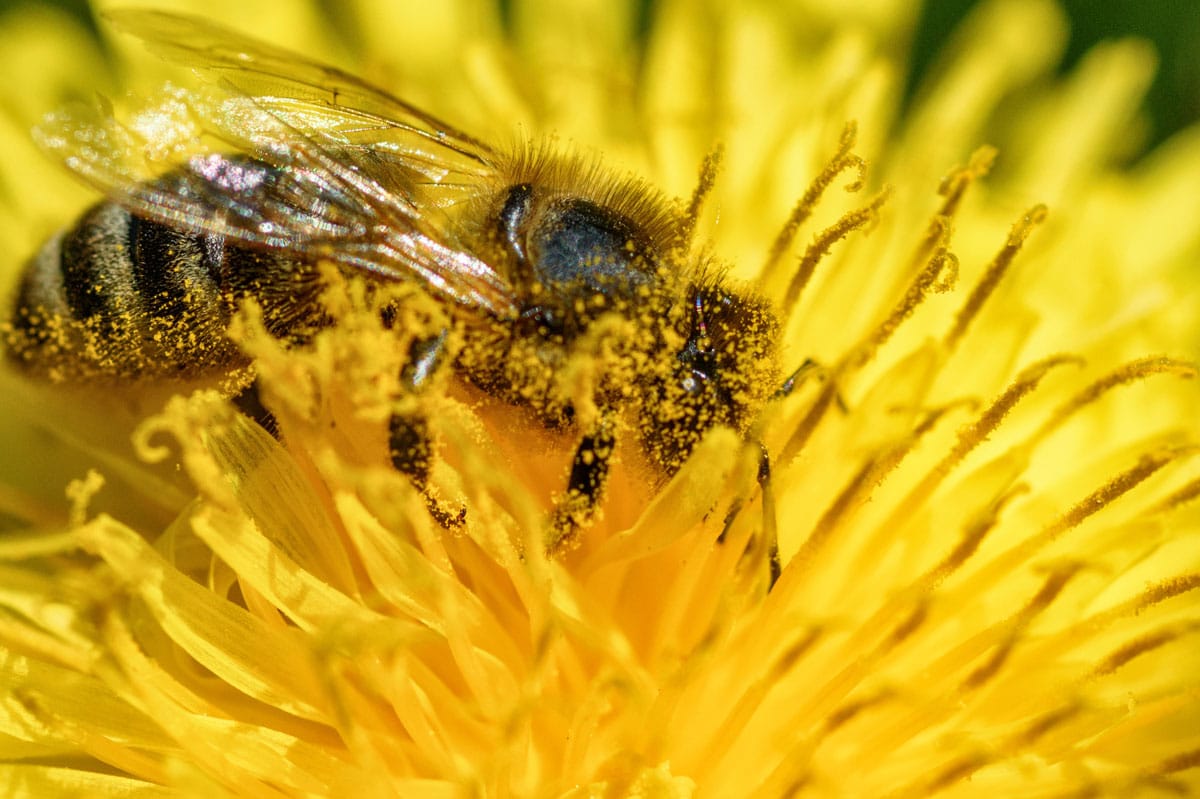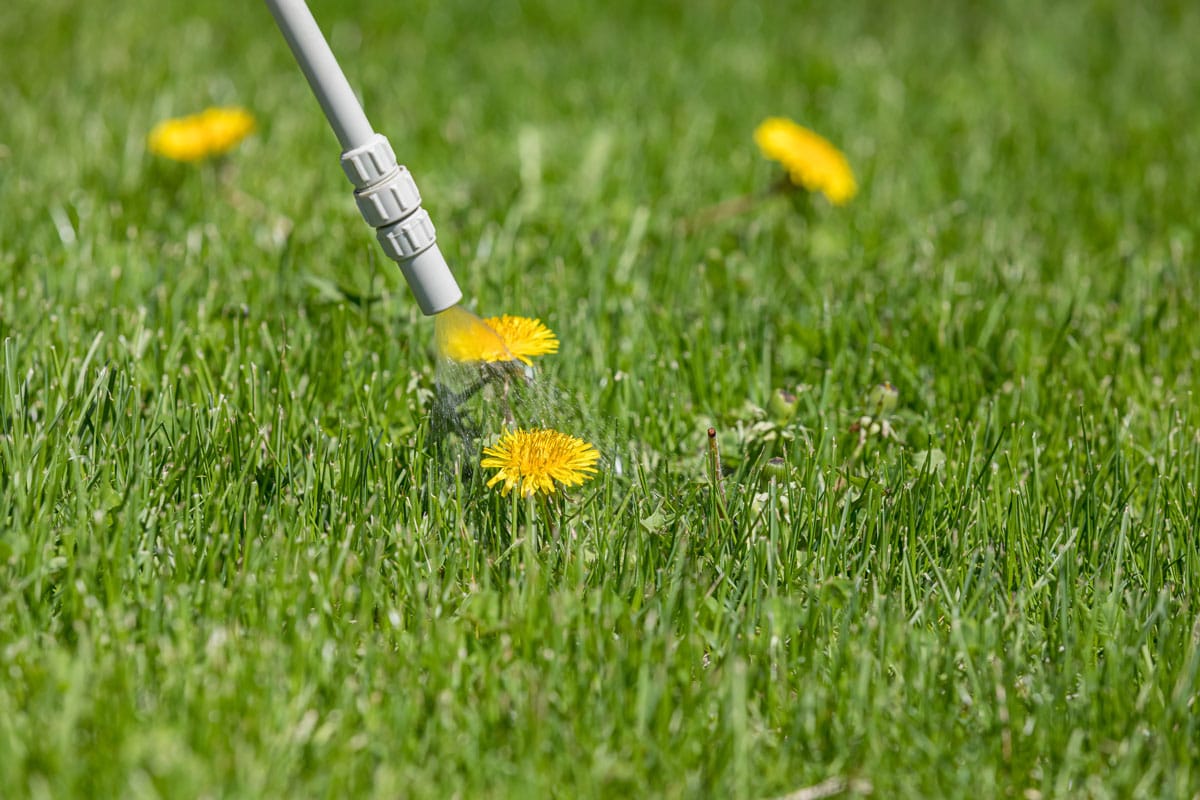They’re bright, zingy harbingers of spring, but do you really want dandelions in your lawn? We’re looking at the pros and cons of dandelions.
Before I get started on the subject of dandelions in your lawn, let me introduce myself. Just lately, Robbie has been super-busy creating videos and so he’s asked me, Angela, to be his ghost writer.
What happens is, Robbie phones up to give me an idea for a blog post and what he wants to say in it. Then I’ll strap myself to my computer, do some fact checking, and translate Robbie’s words into writing.
But here’s the rub, as well as working in the turf industry for over 20 years, I’m a beekeeper. Which means I’m also a big fan of wildlife, wildflowers and biodiversity. So this particular blog comes straight from my heart. I hope it gives you some food for thought.

Seen like this, the dandelion looks like a good candidate for a pretty border flower with bright yellow flowers.
Why Dandelions In Your Lawn Are No Bad Thing
Before you throw your hands up in horror and decide I’m a crazy woman (I prefer the term ‘eccentric’) here’s why I actually like dandelions.
Good for the soil
If ever you’ve tried to dig up a dandelion, you’ll know that it has a long tap root that delves deep into the ground. Break a piece of it off when you’re weeding, and the plant will regenerate from a tiny piece of root.
That tap root reaches much deeper than most of the other plants in your lawn and garden. It can push through the most compacted soil. Where it helps to improve the structure, allowing water to filter through it and other plants to put down roots.
That long reaching tap root also means that the dandelion plant can draw nutrients from deeper underground. Thinks like potassium, calcium, magnesium and of course, water. Do dandelions go brown in summer? No – which is probably one reason why some gardeners don’t welcome dandelions in your lawn.
All of those minerals that have been drawn from deep underground, get stored in the dandelion leaves. When the leaves eventually die, the nutrients stored within them are returned to the soil. But now, they’re in the upper layers of soil and more accessible to lawn grasses and the like. Mother Nature is an absolute genius!
Good for you
The minerals that dandelion plants dredge up from deep in the soil, don’t just benefit your garden. They’re potentially very good for you too. Every part of the dandelion plant is edible. The leaves are fantastic in a salad or they can be made into a refreshing tea. The flowers taste a bit like honey and make an aesthetically pleasing garnish for lots of dishes. I’m told that they make a very nice wine too. I’m not sure that I fancy trying to eat the seeds though – all that fluff is a bit off-putting….unless of course you happen to be a goldfinch or a sparrow.
In the days before the NHS, herbalists would have used dandelions in a number of remedies.
- The sap from dandelion stems is said to cure warts
- Dandelion leaves are rich in potassium, which is great for supporting the nervous system
- Those glorious yellow flowers contain beta-carotene, an antioxidant that protects cells from damage.
- Scientists have recently discovered that dandelions contain bioactive compounds that could help to regulate our blood sugar levels…..research is ongoing on that one.
- Ancient healers believed that dandelion strenthens the liver and the pancreas and acts as a blood purifier
- Tea made from the leaves is said to aid digestion

This little lady certainly seems to appreciate the dandelions in my lawn
Good for biodiversity
All those incredible nutrients packed into one plant, naturally make it a useful food source for all sorts of creatures. Pollinators such as bees, butterflies, hoverflies and a surprising number of moths will flock to feed on dandelions when few other plants are in bloom.
Then of course, there are the birds that feed on dandelion seedbeds and a whole range of mammals that love to browse on the leaves.
I’m very aware though, that whilst you might welcome bumblebees and birds onto your lawn, you’d be less pleased to see a herd of goats on there. You could pick the leaves for your pet rabbits and guinea pigs though – they absolutely adore them!
Feed Your Plants With Dandelion Tea
If you do decide to tolerate dandelions in your lawn, you might want to harvest all of that goodness and put it to work elsewhere in the garden.
Dandelion tea is an excellent liquid feed for fruit, veggies, flower beds and houseplants. And it’s incredibly easy to make.
Pick as many dandelion leaves as you possibly can – gather them from around the garden, whilst walking the dog, from the cracks in your driveway, the supermarket car park – anywhere you see them. Now stuff all of those leaves into a container with a lid. (I use the nappy bucket I had from when my children were small). You need to pack the leaves down tight and then cover them with water. Pop the lid on, leave the container somewhere fairly sheltered so that the leaves can ferment, and forget all about it for about 2 months. When you go back to it, strain the liquid into another container and put the leaves onto the compost heap. It will have a strong smell, but this is liquid gold for the garden. Dilute it 1 part dandelion tea to 3 parts water and use it to water your plants. They’ll love that mineral boost.
What if you still don’t want dandelions in your lawn

I’m pretty sure I won’t be able to convince many lawn lovers that dandelions in the lawn are a good thing. But hopefully you’ll compromise and let some grow in your flower beds.
Anyhow, if you do want to get rid of the dandelions in your lawn, there are a few ways of going about it.
The most eco-friendly way is, of course, to dig them out. The Fiskars Weed Puller makes the job of plucking dandelion plants out of the lawn so much easier. You don’t need to bend your back, get on your knees or make huge holes in your lawn and this beauty is very efficient at getting the whole plant out – roots and all. It’s not just for dandelions – use it for pulling out thistles or for harvesting beetroot in the veg patch.
Buy Your Fiskars Weed Puller online.
You could spot treat any dandelions in your lawn with a systemic weedkiller in a spray bottle – but be careful how you aim the spray – that stuff will kill every plant it touches, including your lawn!
There is a rumour that you can kill any garden weed with either boiling water or with vinegar. Please don’t try either of those methods. Boiling water will kill EVERYTHING including your grass plants and the soil microbes that help to keep your lawn alive. Vinegar is acetic acid and so, at the very least it will mess with the pH of your soil. Doing that will affect the way that soil nutrients behave and could make them less available to your lawn. In any case, for vinegar to kill weeds it must be at a really high concentration – and nobody should be handling concentrated acids without proper training and equipment.
Blanket weed treatments
For a nasty infestation of dandelions in your lawn, you’ll probably want to blanket treat the lawn with a selective herbicide. You could either apply a generic weed and feed treatment (although I think they’re expensive for what they are) or you could ask a lawn care professional to carefully spray the area for you.
If you are applying weedkiller yourself, be sure to follow the manufacturers instructions to the letter. Don’t spray if there is even the slightest breeze – selective herbicides are clever, but they can’t tell the difference between dandelions and dahlias so any spray drift could damage the rest of your garden. And don’t forget to wash your sprayer out thoroughly afterwards, especially if you plan to use it for other lawn treatments in the future. In fact, I’d be inclined to keep one sprayer (or watering can) exclusively for weedkiller – that way you’ll stand a better chance of avoiding accidents.
How do you treat dandelions in your lawn? Head on over to the Premier Lawns Community Page on Facebook and join in the conversation.
You might also like
Buy Your Fiskars Weed Puller online for eco-friendly weed control
Clover in your lawn – should it stay or should it go?
A beginners guide to getting rid of lawn weeds.
